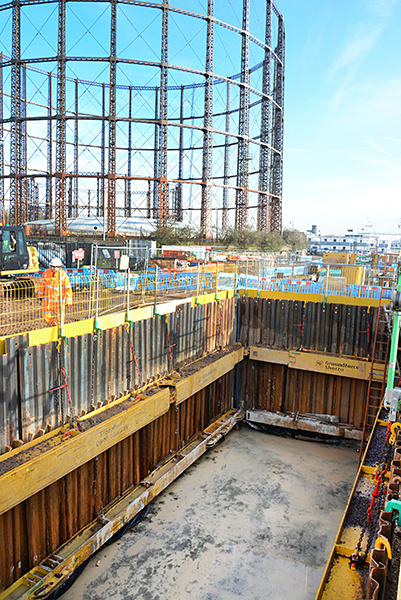
Health and safety is of paramount importance when working in excavations, with a whole host of obvious – and some not so obvious – hazards to consider. Chris Gearren, Groundforce general manager – training (national) recently answered Project Scotland’s questions on the subject.
Q) How do you define an excavation?
A) An excavation is defined as including any earthwork, trench, well, shaft, tunnel or underground working and is one of the most unpredictable construction areas to work in. The principal reasons for this are local variations in the water table, ground conditions and the presence of underground services.
Q) What does the law say about working in and/or around excavations?
A) The Construction (Design and Management) Regulations 2015 requires that steps are taken to prevent danger to any person by providing supports, to ensure no part of the excavation collapses, no person or material can fall into the excavation, prevent any part of the excavation being overloaded (ie with work equipment or material), and make certain the excavation, equipment and materials used that might affect its safety are inspected by a competent person.
The person who has inspected the work equipment and materials must be satisfied that the work can be carried out safely. If they are not, they must notify the person they were inspecting for and where they have done so, as work cannot be carried out until the matter has been ‘satisfactorily remedied’.
Q) What are some of the most common dangers/hazards?
A) Sadly, every year people are killed or seriously injured working in and/or around excavations. Most people understand there is grave danger from collapse and being buried alive. However, many of the other hazards are not always considered. These include being struck or trapped by the collapse of the sides, equipment and people falling into the excavation, or falling into flooded excavations and drowning if the excavation floods.
(There is also a) risk of asphyxiation/chemical/substance exposure from ground contamination, damaging existing underground pipelines/sewers or from the activity carried out in or near to the excavation, burns and electric shock caused by damaging existing underground services as well as the collapse of nearby structures undermined by the excavation, and falls from height when accessing and leaving the excavation.
Wherever possible, the risks should be reduced to as low a level as possible using the hierarchy of risk control to eliminate the risks. Anyone who undertakes or supervises excavation work should be sufficiently trained or experienced in that type of work and not endanger themselves or others. Good excavation practice is to ensure no section is started unless it can be made safe and secure before, and at the end of the shift/day.
Q) What factors should be taken into consideration to mitigate the risks?
A) Before any excavation work commences information on the ground conditions should be obtained. On site, this may be available in the CDM health and safety file or construction phase plan. Additional information can also be obtained on the ground contaminants, both natural and due to previous uses of the site, underground services and whether these belong to the owners or the utility companies, previous shafts, mines or basements, any natural underground watercourses, and results of any site investigations/surveys.

Q) How has health and safety in this area evolved over the years?
A) With the introduction of easy to use proprietary shoring systems, equipment can be rapidly built and installed. As part of all projects that involve excavations, the identification of the hazards will lead to the selection and use of the appropriate methods of ground support to protect all employees who may have to enter.
The type of support is determined by the type and depth of material requiring support, the activity of the water table, and the amount of available space. If support structures are used they must be in good condition and proven by calculation to be able to withstand all imposed forces during installation, use and removal. Supports need at least daily monitoring.
Hazards associated with installation include the risk of falling into the excavation and the risk of contact with moving materials and equipment.
The system of support selected should always provide the highest level of safety to the installer. The main benefit of proprietary systems over traditional methods is that the installer does not need to enter the excavation until it is safe. Other advantages include installation (in most cases) can be carried out without the need to enter the excavation and there are a wide range of equipment options to suit various applications. Increased working space is available for ease of excavation and pipe-laying, and the availability of technical advice on selection, installation and use is plentiful.
With regards to training, the industry has recognised there is a requirement to train those who are involved with the installation and use of appropriate ground support systems.
Q) How have contractors reacted to this shift of importance of training?
A) As a whole, contractors have embraced accredited safety training in general and recognise that in order to win certain types of work, and be accepted onto various construction sites, they must have proof of trained staff. When it comes to excavation training there has been a huge shift towards getting more people qualified. However, there are still thousands of individuals carrying out excavation work who have not been trained. Those employers and individuals hold a deeply held belief that they don’t require training due to their experience.
Q) What work is there to do in the next 10 years?
A) Tier 1 contractors as well as all sub-contractors will have an increased opportunity to educate themselves on what is probably the most dangerous job carried out on-site. When we think of the top risks for death on-site, many would agree it’s falls from height, being struck by an object, being caught in or between an object (crushing), and plant interface. Working in and around excavations often presents all of these hazards at once.
Q) What should the industry be doing more of?
A) Simplification is key and tier 1 contractors should be considering the principal training they require of their contractors to be carrying out essential tasks on their sites. Too often there is a view to ensure training in areas such as plant or usage of mobile elevated work platforms, with groundworks being largely forgotten.
So, I would say the work to be done for everyone is to continue to risk assess and manage risks, but also strongly consider the specialist accredited excavation training required to help complete the circle of competency for everyone involved in this activity.
Q) What training does Groundforce provide on the topic?
A) As a business, VPPLC Groundforce has a dedicated training division that can deliver multiple nationally awarded and accredited courses which meet the requirements of the industry with regards to the use, installation, inspection and removal of various ground support systems. The training can be delivered both at a number of dedicated training sites as well as customer sites where they meet the requirements of the awarding body.












